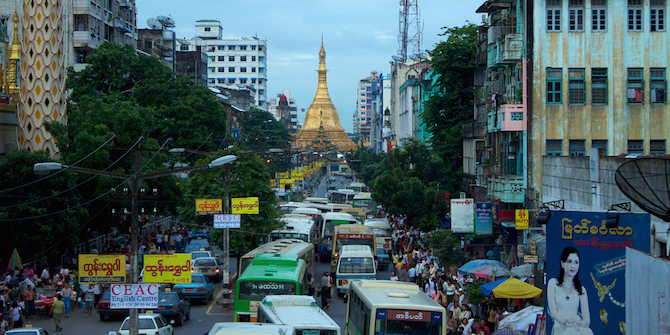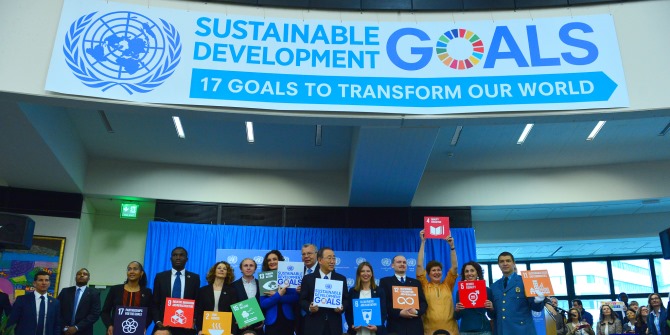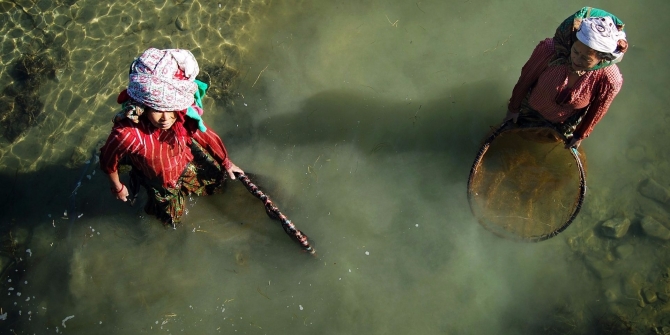Mikaela Rambali asks how the Ganges is simultaneously venerated and disastrously neglected across India.
Early one morning in Kerala, I booked a yoga session with an amazing view of the backwaters. When I arrived, it turned out to be a meditation class. It was quite an experience for me to spend a whole hour learning how to relax my pancreas and my kidneys. At the end of this inner journey, the teacher asked me what I thought. I replied that I could now better understand why so many people meditate along the Ganges when the sun rises each day. The teacher’s eyes glazed over. He said he felt shivers when I pronounced the name Ganga, and that the mere mention of a river would never evoke such reverence in France, where I come from.
Water is essential to life and the stakes of its management are as serious at a global level as at a local level. The water of the Ganges, the “blue gold” of northern India, is increasingly exploited because of the growth of India’s population and economy. Ranked by the World Wildlife Fund among the 10 world rivers most at risk because of water over-extraction, the Ganges and its future should be a serious cause for concern across India. All the more so because “mother” Ganges, sacred in Hindu mythology, is worshipped by hundreds of millions of people. In this respect, a paradox lies in this river: how can the Ganges be venerated and at the same time disastrously neglected?
One explanation for the depletion of the Ganges is the subcontinent’s booming economy, for which the river is being drained. Present in the lives of 400 million people who live in its basin, the Ganges represents nearly one quarter of India’s water resources. Its exploitation is unavoidable to satisfy growing needs. The demand for energy has encouraged the development of hydroelectric stations upstream. Food production, which depends on irrigation, is also increasing with the growth of the population and income per capita. Industry, another thirsty sector, will continue to increase its water use in view of the growing population and incomes. All these sectors – power, agriculture and industry – view the Ganges as an abundant and cheap raw material.
As a consequence, the water’s quality is deteriorating and extraction is continuing at an unsustainable rate. This has harmful impacts on the river’s ecosystem and on the well-being of local populations, who are victims of many waterborne diseases despite the fact that some scientists claim Gangajal has a high oxygen recycling capacity.
Questions about the duality of the Ganges have to be considered from a religious perspective. For Hindus, the dissociation between the purity and cleanliness of the Ganges can be explained by the fact that one represents the transcendental power of the river and the other is its tangible form. The cleanliness of the river is not in any way conditional to its purity. Hindus make a distinction between the material and the spiritual, explaining the paradox that the river’s purifying waters can also be used for waste disposal. That said, the concept of ‘pollution’ is raising confusion, with a blurring of the frontiers between ritual impurity and material dirt.
Religious leaders have refrained from mixing concepts that according to them have nothing to do with each other: the depletion of the physical world does not interfere with the transcendental purity of the Ganges. Spiritual rituals should not be merged with civic ethics, they say. However, Veer Bhadra Mishra, a Hindu high priest and hydraulic engineer, conceded that the spiritual and physical natures of the purity of the Ganges have to become complementary. He is now a member of the National Ganga River Basin Authority, a planning, financing and monitoring authority for the Ganges established in 2009.
How will Ganga Ma survive if there is no more water in her bed? Pollution and over-extraction will not necessarily jeopardise the divine nature of the river but they will weaken one of the pillars of Hindu culture—no doubt, the purity of the Ganges is challenged by India’s development. But there is also hope for the future cleanliness of the river as younger generations are increasingly aware of environmental challenges. A Hindu student of Delhi’s Indian Institute of Technology once told me he thought his generation would take care of the river, not because they consider her a goddess but because it is wrong to act against their own environment.
To make the Ganges a lasting resource, it seems that India has to learn from the mistakes of industrialised countries in order to combine its development path with respect for its resources, starting by assessing the depletion caused by exploitation. This challenge is even greater than cleaning up the Rhine, primarily because India’s population already exceeds a billion and owing to underlying antagonisms between Hindus and the polluters, notably in the tanning industry. A way to reconcile the lessons from the West’s errors with India’s ambitions has to be found. And for the message to be conveyed to the local population, a new development model issued from their own culture has to emerge.
Mikaela Rambali is a master’s student in LSE’s Department of Geography and Environment.








Great insight about the subject. A problem that is not only from one nation in my opinion, but shared by many.
I am in favour of the living rivers.
Dear friend
Thanks for composing an article about the issue of the Ganges conservation, which is as iconic as river itself.Like many rivers worldwide the Ganges is also an example of pressures exerted by population and economic growth.The over extraction of water from river becomes necessary due to growing needs for food production.
Actually its not India/n alone who pollutes this river or extracts its water. In current globalized scenario countries importing food grains ( e.g Basmati etc) also actually import river water ( Virtual water). People wearing clothes , shoes prepared in cities (due to cheap labour) along the Ganges also contribute in its pollution.
In near future India is hopeful about health of the Ganges and highly capable teams of IIT engineers are engaged in restoration plans. Public awareness still is lacking , but increasing very fast.
Please post your article on our website to diversify its contents.